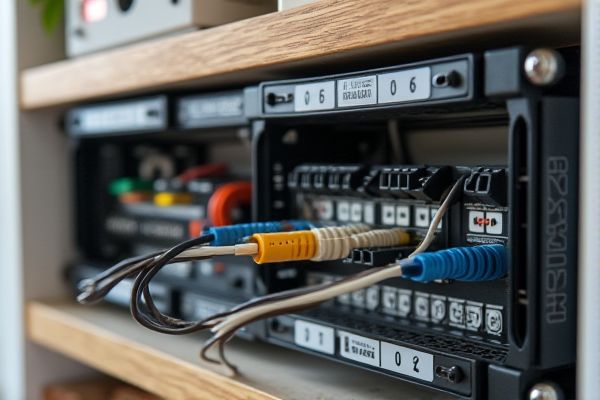
Cable trays offer an open, flexible pathway for organizing and supporting electrical cables, allowing for easy access and ventilation, while cable boxes provide enclosed protection, shielding cables from dust, moisture, and physical damage. Understanding the differences between cable trays and cable boxes can help You choose the most suitable solution for efficient cable management; explore the full article to dive deeper into their applications and benefits.
Table of Comparison
| Feature | Cable Tray | Cable Box |
|---|---|---|
| Definition | Open framework for supporting and routing cables. | Enclosed container for housing and protecting cables. |
| Material | Metal or fiberglass, usually perforated or ladder type. | Metal or plastic, fully enclosed and sealed. |
| Protection | Minimal; exposes cables to open air. | High; shields cables from dust, moisture, and impact. |
| Accessibility | Easy access for cable maintenance and upgrades. | Limited access; requires opening the box. |
| Installation | Mounted on walls, ceilings, or under floors. | Fixed in place where cables enter equipment or junctions. |
| Use Case | Ideal for supporting large cable runs in industrial settings. | Used for junction points, connections, and terminations. |
| Cost | Generally lower cost due to simpler design. | Higher cost because of full enclosure and protection features. |
Overview: Cable Tray vs Cable Box
Cable trays provide an open support system for routing electrical cables, allowing for easy installation, ventilation, and maintenance, while cable boxes offer enclosed protection to safeguard cables from environmental factors and physical damage. Cable trays are typically used for larger cable volumes in industrial or commercial settings, ensuring organized cable management and heat dissipation. Your choice depends on whether visibility and airflow or protection and containment are prioritized in the installation environment.
Definition and Core Functions
A cable tray is a structural system used to support and organize large bundles of electrical cables, providing easy access for maintenance and future expansion. A cable box, on the other hand, is an enclosed container designed to protect and house smaller cable connections and junctions from environmental damage and tampering. Your choice depends on whether you need open cable management for routing or secure protection for critical cable connections.
Material Composition and Durability
Cable trays are typically made from materials like steel, aluminum, or fiberglass, offering high durability and resistance to environmental factors such as corrosion and mechanical stress. Cable boxes, often constructed from plastic or metal, provide enclosed protection but may vary in durability based on material thickness and quality. Your choice should consider the installation environment and required longevity to ensure optimal performance.
Installation Process: A Comparative Guide
Cable tray installation involves securing modular components like trays, supports, and fittings to walls or ceilings, enabling easy cable management and future expansion. Cable box installation requires mounting enclosed boxes at specific points with pre-cut access holes, providing enhanced protection and organized routing for cables. Selecting between tray and box systems depends on project scale, environmental conditions, and accessibility requirements for maintenance.
Cable Management Efficiency
Cable trays offer superior cable management efficiency by providing open pathways that allow easy access, better ventilation, and straightforward cable organization for large-scale installations. Cable boxes, while more enclosed and protective, often limit accessibility and make modifications or troubleshooting more time-consuming. Your choice depends on balancing the need for efficient cable routing with the desired level of protection and ease of maintenance.
Space Utilization and Flexibility
Cable trays offer superior space utilization by allowing cables to be organized in open, easily accessible channels with customizable widths, making them ideal for large or evolving wiring systems. Cable boxes, while more compact, provide limited flexibility due to enclosed spaces that restrict cable routing and expansion options. Your choice depends on the need for adaptability and efficient use of vertical and horizontal space in your installation.
Safety and Compliance Considerations
Cable trays offer superior ventilation and heat dissipation, reducing fire risks and meeting National Electrical Code (NEC) safety standards more effectively than cable boxes. Cable boxes, while providing enclosed protection from physical damage, can trap heat and require additional considerations for grounding and fire resistance compliance. Proper selection between cable trays and cable boxes depends on project-specific safety requirements, including load capacity, environmental conditions, and local electrical codes.
Maintenance and Accessibility
Cable trays offer superior maintenance and accessibility by allowing easy visualization and access to cables, which simplifies upgrades and troubleshooting. Cable boxes, while protecting cables from environmental damage, often require more effort to open and inspect, leading to longer maintenance times. You can achieve faster cable management and ensure better airflow with cable trays, making them ideal for environments where frequent access is necessary.
Cost Comparison: Upfront and Long-Term
Cable trays generally offer a lower upfront cost due to simpler materials and installation processes compared to cable boxes, which require more labor and higher material expenses. Over the long term, cable trays provide easier access for maintenance and scalability, reducing operational costs, while cable boxes may incur higher expenses due to limited flexibility and the need for frequent upgrades. Choosing the right option depends on your project's scale, budget constraints, and maintenance priorities.
Choosing the Best Option: Key Applications
Cable trays offer superior ventilation and easy access for large-scale industrial or commercial wiring projects, making them ideal for applications requiring frequent cable additions or maintenance. Cable boxes provide a compact, protective enclosure suited for environments where cable organization and protection from dust or physical damage are critical. Consider your installation's scale, environmental exposure, and maintenance needs to determine whether a cable tray or cable box best supports your wiring system's efficiency and longevity.
 homyna.com
homyna.com